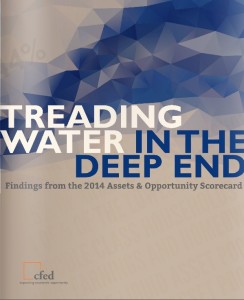 Working in the nonprofit sector and philanthropy, it helps to be a bit of a data nerd. Increasingly, tracking, crunching, and assessing data is not just a “nice to do” but a “must do.” At The Women’s Foundation, we work hard to make sure we’re investing in strategies that are data-driven and evidence-based.
Working in the nonprofit sector and philanthropy, it helps to be a bit of a data nerd. Increasingly, tracking, crunching, and assessing data is not just a “nice to do” but a “must do.” At The Women’s Foundation, we work hard to make sure we’re investing in strategies that are data-driven and evidence-based.
For those who are not data nerds, it helps when data tells a real story of a woman’s life. That’s why I do a happy dance when CFED launches its annual “Assets & Opportunity” scorecard. The scorecard is user-friendly and includes data beyond financial assets, such as education, health and jobs.
So, what does the 2014 scorecard tell us about the lives of women and families in the Washington region[i]? Here are a few things that struck a chord for me:
- DC and Maryland have stronger asset building policies, and stronger outcomes for families. Virginia has weaker policies, and weaker outcomes for families. For example, DC and Maryland have eliminated “asset tests” for SNAP (the Supplemental Nutrition Assistance Program, or food stamps) that discourage recipients from building the savings that could otherwise help them move toward self-sufficiency.
- Maryland has the highest adoption of asset building policies in the US – but it’s still only 60% of what could be adopted.
- DC has the worst ratio of homeownership rates in the US, comparing the rate between two-parent (67.7%) and one-parent households (29.2%). This, to me, says a lot about the financial status of one-parent households in the District, and the importance of investing in asset building for the low-income women we aim to serve.
When the scorecard comes out, I also always look at the “liquid asset poverty rate.” It’s a jargon-y term for the savings on hand (cash and other accounts that can be liquidated quickly) to help individuals and families in the event of a crisis, like a job loss or medical emergency. What I’m always shocked to think about is that these assets are what allow someone to “subsist at the poverty level for three months in the absence of income.” We’re talking about the ability to simply subsist at poverty levels, which is awfully close to slipping below, and is certainly not enough to get by in our region.
- In Virginia, 51.8% of single female-headed households live in liquid asset poverty.
If it’s a two-parent household, this rate drops to 27.5%.
- In Maryland, 48.4% of single female-headed households live in liquid asset poverty.
If it’s a two-parent household, this rate drops to 21.4%.
These numbers are consistent – or in some cases even lower – than national rates, but they are nevertheless striking. If half of female-headed households are living in liquid asset poverty – meaning they don’t have the savings to cover three months of basic expenses, let alone the savings to plan for the future – then we have a lot of work to do.
I encourage you to dig deep into the data. Find out how it speaks to you.
Lauren Stillwell is a program officer at Washington Area Women’s Foundation.


